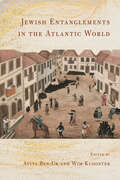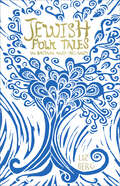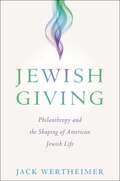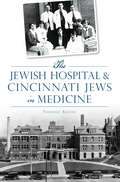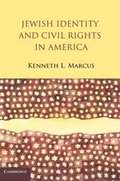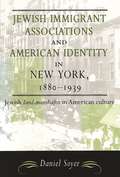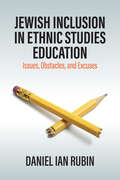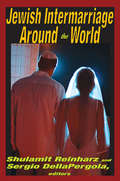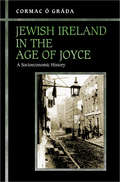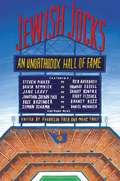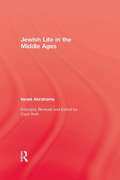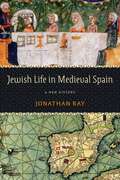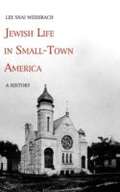- Table View
- List View
Jewish Encounters with Buddhism in German Culture: Between Moses and Buddha, 1890–1940 (Palgrave Series in Asian German Studies)
by Sebastian MuschIn Germany at the turn of the century, Buddhism transformed from an obscure topic, of interest to only a few misfit scholars, into a cultural phenomenon. Many of the foremost authors of the period were profoundly influenced by this rapid rise of Buddhism—among them, some of the best-known names in the German-Jewish canon. Sebastian Musch excavates this neglected dimension of German-Jewish identity, drawing on philosophical treatises, novels, essays, diaries, and letters to trace the history of Jewish-Buddhist encounters up to the start of the Second World War. Franz Rosenzweig, Martin Buber, Leo Baeck, Theodor Lessing, Jakob Wassermann, Walter Hasenclever, and Lion Feuchtwanger are featured alongside other, lesser known figures like Paul Cohen-Portheim and Walter Tausk. As Musch shows, when these thinkers wrote about Buddhism, they were also negotiating their own Jewishness.
Jewish Entanglements in the Atlantic World
Jewish Entanglements in the Atlantic World represents the first collective attempt to reframe the study of colonial and early American Jewry within the context of Atlantic History. From roughly 1500 to 1830, the Atlantic World was a tightly intertwined swathe of global powers that included Europe, Africa, North and South America, and the Caribbean. How, when, and where do Jews figure in this important chapter of history? This book explores these questions and many others. The essays of this volume foreground the connectivity between Jews and other population groups in the realms of empire, trade, and slavery, taking readers from the shores of Caribbean islands to various outposts of the Dutch, English, Spanish, and Portuguese empires.Jewish Entanglements in the Atlantic World revolutionizes the study of Jews in early American history, forging connections and breaking down artificial academic divisions so as to start writing the history of an Atlantic world influenced strongly by the culture, economy, politics, religion, society, and sexual relations of Jewish people.
Jewish Experiences across the Americas: Local Histories through Global Lenses
by Katalin Franciska Rac Lenny A. Ureña ValerioLatin American Jewish Studies Association Best Edited VolumeThis volume explores the local specificities and global forces that shaped Jewish experiences in the Americas across five centuries. Featuring a range of case studies by scholars from the United States, Brazil, Europe, and Israel, it explores the culturally, religiously, and politically diverse lives of Jewish minorities in the Western Hemisphere.The chapters are organized chronologically and trace four global forces: the western expansion of early modern European empires, Jewish networks across and beyond empires, migration, and Jewish activism and participation in international ideological movements. The volume weaves together into one narrative the histories of communities and individuals separated by time and space, such as the descendants of Portuguese converts, Moroccan immigrants to Brazil, and U.S.-based creators of Yiddish movies.Through its transnational focus and close attention paid to local circumstances, this volume offers new insights into the multicultural pasts of the Americas’ Jewish populations and of the different regions that make up North, Central, and South America.Contributors: Lenny A. Ureña Valerio | Elisa Kriza | Raanan Rein | Adriana M. Brodsky | Lucas de Mattos Moura Fernandes | Katalin Franciska Rac | Zachary M Baker | Neil Weijer | Hilit Surowitz-Israel | Isabel Rosa Gritti | Tamar Herzog | Jose C Moya | Sandra McGee Deutsch | Dana RabinPublication of this work made possible by a Sustaining the Humanities through the American Rescue Plan grant from the National Endowment for the Humanities.
Jewish Family and Children's Service of Greater Philadelphia (Images of America)
by Allen MeyersJewish Family and Children's Service of Greater Philadelphia (JFCS) resulted from the merger of two important human service organizations in 1983: the Association for Jewish Children of Philadelphia and Jewish Family Service of Philadelphia. Helping one in four Jewish households in crisis and in need as well as thousands of others, JFCS plays a primary role in the Greater Philadelphia community. The earliest predecessor of JFCS, the Jewish Foster Home, opened in 1855 with five children in its care. Established through the leadership of Rebecca Gratz, the foremost American Jewish female leader of her day, it was the nation's first Jewish orphanage and heralded a record of compassion, skill, and innovation in community services. Today, JFCS reaches out to more than 41,000 individuals and families each year with a wide array of programs from adoption to senior services. Jewish Family and Children's Service of Greater Philadelphia is the first illustrated history of this organization. With numerous historic photographs, including images from the 150th anniversary celebration in 2005, this book touches on all aspects of the organization's history: services, programs, staff, and fund-raising.
Jewish Family: Identity And Self-Formation At Home (The Modern Jewish Experience)
by Alex Pomson Randal F. SchnoorIn Jewish Family: Identity and Self-Formation at Home Alex Pomson and Randal F. Schnoor advance a new appreciation for the deep significance of Jewish family in developing Jewish identity. This book is the result of ten years of research focused on a small sample of diverse families. Through their work, the authors paint an intricate picture of the ecosystem that the family unit provides for identity formation over the life course. They draw upon theories of family development as well as sociological theories of the transmission of social and cultural capital in their analysis of the research. They find that family networks, which are often intergenerational, are just as significant as cultural capital, such as knowledge and competence in Judaism, to the formation of Jewish identity. Pomson and Schnoor provide readers with a unique view into the complexity of being Jewish in North America today.
Jewish Folk Tales in Britain and Ireland (Folk Tales)
by Liz BergIn this book of folk tales, Liz Berg shares Jewish memories: authentic tales, songs and jokes told by Jews in Britain and Ireland. Some stories moved from place to place, changing and adapting to new landscapes and taking on different textures, but the core of the story stays the same and is preserved through oral storytelling and recorded on these pages. Here are tales from the time of Domitian’s Jewish slaves working in the tin mines of Cornwall, through to the tales being told in communities today, all incorporating the wit and magic of a rich and varied culture successfully integrated into Britain and Ireland.
Jewish Giving: Philanthropy and the Shaping of American Jewish Life
by Jack WertheimerEvaluating Jewish donors over timeThe American Jewish philanthropic enterprise is unparalleled in scope, dynamism, and the diversity of funders and the causes they support. Yet even as Jewish giving has been largely successful in responding with alacrity to emergencies, it has been subjected to severe criticism. What once was regarded as a point of pride has become the object of scorn and dismissal, with skepticism—if not harsh criticism—about its work rife both within and outside Jewish communal circles.Based on 320 interviews with professionals at Jewish not-for-profits across the United States, principals of foundations and their top staff personnel, and also tax filings of major foundations, Jewish Giving provides readers with fresh perspectives to evaluate the efforts of Jewish donors, large and small. The book traces the evolution of Jewish giving from the colonial era to the present, charting the changing profile of those who give to Jewish causes and what funders have aimed to achieve through their largesse. It makes the case that philanthropy serves as a prism through which broader themes in communal life are illuminated. As society or politics change, the priorities of charitable giving adjust in response. These changes in targeted funding can help to sharpen our understanding of demographic and social patterns. Devoting much attention to twenty-first century developments in contemporary Jewish giving, the book pays special attention to the changing landscape of donors who are remaking Jewish philanthropy, including women, Orthodox Jews, Sephardi givers, and young funders.
Jewish Hospital & Cincinnati Jews in Medicine, The (American Heritage)
by Frederic KromeCincinnati Jewish Hospital has remained a beacon of service to the city for more than a century and a half. Although it always accepted patients regardless of their heritage or faith, the institution maintains its Jewish identity. Founded in 1850, the Hospital weathered depressions and wars while reflecting changes that occurred within the Jewish community and the city. Cincinnati's Jewish health professionals pioneered medical education, new treatments for polio and the introduction of new psychological treatments for children. Author Frederic Krome explores the fascinating history of the Cincinnati Jewish Hospital and the many contributions Cincinnati Jews made to the field of medicine.
Jewish Hungarian Orthodoxy: Piety and Zealotry (Routledge Jewish Studies Series)
by Menachem Keren-KratzBeginning with the informal establishment of Jewish Orthodoxy by a Hungarian rabbi in the early nineteenth century, this book traces the history and legacy of Jewish Hungarian Orthodoxy over the course of the last 200 years. To date, no single book has provided a comprehensive overview of the history of Hungarian Orthodoxy, a singularly zealous, fundamental, and separatist faction within Jewish circles. This book describes and explains the impact of this strand of Jewish Orthodoxy – developed in Hungary in the second half of the nineteenth century – across the Jewish world. The author traces the development of Hungarian Orthodoxy in the “new” Jewish territories created in the wake of Hungary’s dismantlement following its defeat in World War I. The book also focuses on Hungarian Orthodoxy in the two spheres where it continued to develop after the Holocaust, namely Israel and the United States. The book concludes with a review of Hungarian Orthodoxy’s legacy in contemporary communities worldwide, most of which are known for their radical anti-Zionist and anti-modernistic strands. The book will prove vital reading for students and academics interested in religious fundamentalism, Hungarian history, and Jewish studies generally.
Jewish Identities in American Feminist Art: Ghosts of Ethnicity
by Lisa E. BloomFeaturing sixty-seven illustrations, and providing an important reckoning and visualization of the previously hidden Jewish 'ghosts' within US art, Jewish Identities in American Feminist Art addresses the veiled role of Jewishness in the understanding of feminist art in the United States. From New York city to Southern California, Lisa E. Bloom situates the art practices of Jewish feminist artists from the 1970s to the present in relation to wider cultural and historical issues. Key themes are examined in depth through the work of contemporary Jewish artists including: Eleanor Antin Judy Chicago Deborah Kass Rhonda Lieberman Martha Rosler and many others. Crucial in any study of art, visual studies, women's studies and cultural studies, this is a new and lively exploration into a vital component of US art.
Jewish Identities in Contemporary Europe
by Andrea Reiter and Lucille CairnsProviding an assessment of Jewish identity, this volume presents critical engagements with a number of Jewish writers and filmmakers from a variety of European countries, including Austria, France, Germany, Poland, and the UK. The novels and films discussed explore the meaning of being Jewish in Europe today, and investigate the extent to which this experience is shaped by factors that lie outside the national context, notably by the relationship to Israel. As the recent attacks on Charlie Hebdo, and the targeting of a Jewish supermarket in Paris, demonstrate, these questions are more pressing than ever, and will challenge Jews, as well as Jewish writers and intellectuals, as they explore the answers.This book was originally published as a special issue of Jewish Culture and History.
Jewish Identities in German Popular Entertainment, 1890-1933
by Marline OtteIn 1968, Hollywood adopted a new ratings system that replaced the 1930 Production Code based on prior censorship. Vaughn (history of communications, U. of Wisconsin--Madison) describes industry and government efforts to regulate and control movie content in the wake of that sea change. He first describes the institution of the new system and the reaction of moviemakers. Ratings and other controversies surrounding sex, profanity, violence, drugs, and religion in the movies are then discussed. A number of chapters explore the evolution of the X rating, its association with pornography, the antipornography crusades of Reagan administration Attorney General Meese and others, and the recent institution of the NC-17 rating. One chapter considers similar issues for television. Annotation ©2006 Book News, Inc. , Portland, OR (booknews. com)
Jewish Identity and Civil Rights in America
by Kenneth L. MarcusGiven jurisdiction over race and national origin but not religion, federal agents have had to determine whether Jewish Americans constitute a race or national origin group. They have been unable to do so. This has led to enforcement paralysis, as well as explosive internal confrontations and recriminations within the federal government. This book examines the legal and policy issues behind the ambiguity involved with civil rights protections for Jewish students. Written by a former senior government official, this book reveals the extent of this problem and presents a workable legal solution.
Jewish Identity in Multicultural Australia (Contemporary Anthropology of Religion)
by Jennifer CreeseThis book offers a timely insight into ideas of ‘belonging’ in multicultural society from a Jewish perspective, one which is largely missing from the discourse on multiculturalism. There is a current climate in Australia, as there is in the United States, Europe and elsewhere, of rising tensions around migration, religious freedom, and far right extremism. These tensions have been fanned the Israeli-Palestine conflict coming under increased international scrutiny in recent months. Understanding how Jewish communities attempt to build and guide an understanding of what Jewishness means in contemporary multicultural societies is crucial for supporting the right to safety in diversity, not only for Jews but for multiple minority groups. In delivering such understanding, this book has insights not only in an Australian, but a broader international, context.This book explores how various facets of Jewish life are experienced and expressed in Australia, drawing on rich ethnographic and archival research conducted within the mid-sized Jewish community in South-East Queensland, Australia, which has never before been examined. Jewish Identity in Multicultural Australia explores how Jewish identity is manifested and experienced across a wide range of facets: religion and religiosity, ethnicity and ethnonational identity, history and memory, antisemitism and racism, Zionism and diasporic identity, and family and kinship. Across these key themes, the book builds on a core argument: that contemporary Jewish communities work in certain, set ways and promote certain, set norms within a framework of state multiculturalism to forge a safe, supported place for Jewish life, practice and identity of all shapes and sizes.
Jewish Immigrant Associations and American Identity in New York, 1880-1939: Jewish Landsmanshaftn in American Culture (American Jewish Civilization Series)
by Daniel SoyerLandsmanshaftn, associations of immigrants from the same hometown, became the most popular form of organization among Eastern European Jewish immigrants to the United States in the late 19th and early 20th centuries. Jewish Immigrant Associations and American Identity in New York, 1880-1939, by Daniel Soyer, holds an in-depth discussion on the importance of these hometown societies that provided members with valuable material benefits and served as arenas for formal and informal social interaction. In addition to discussing both continuity and transformation as features of the immigrant experience, this approach recognizes that ethnic identity is a socially constructed and malleable phenomenon. Soyer explores this process of construction by raising more specific questions about what immigrants themselves have meant by Americanization and how their hometown associations played an important part in the process.
Jewish Inclusion in Ethnic Studies Education: Issues, Obstacles, and Excuses
by Daniel Ian Rubin RubinThe function of ethnic studies education in K-12 schools remains a deeply contentious issue within the U.S. Often based on university ethnic studies courses, its focus on the lived experiences of Black, Latino, Indigenous, and Asian/Pacific Islander communities is predictably the target of much conservative commentary, leaving its disregard for the lives of American Jews underexplored. Focusing on how this absence correlates with the rising spate of antisemitism within the U.S., Jewish Inclusion in Ethnic Studies Education provides a clarifying re-examination of the current issues and oversights affecting ethnic studies teaching. In doing so, Daniel Ian Rubin illuminates the possibilities a reformed ethnic studies program offers for eliminating antisemitism among the next generation.
Jewish Insights on Death and Mourning
by Jack RiemerThis collection of Jewish reflections on issues of death and dying make this an indispensable resource for coping with some of life's most difficult moments.
Jewish Intermarriage Around the World
by Sergio DellaPergolaMost research on intermarriage between Jews and non-Jews focuses on the United States. This volume takes a path-breaking approach, examining countries with smaller Jewish populations so as to better understand countries with larger Jewish populations. It focuses on intermarriage in Great Britain, France, Scandinavia, the Soviet Union, Mexico, Venezuela, Canada, South Africa, Australia, Argentina and Curacao, then applies the findings to the United States.In earlier centuries such a volume might have yielded much diff erent conclusions. Then Jews lived in more countries, intermarriage was not as prevalent, and social science had little to contribute. Before World War II, the Jewish population was dispersed much diff erently, and it continues to shift around the world because of both push and pull factors. Like demography, intermarriage is a dynamic process. What is true today was probably not true in the past, nor will it be true tomorrow.The contributors to this volume locate new forms of Jewish family life—single parents, gay/lesbian parents, adults without children, and couples with multiple backgrounds. These multiple family forms raise a new question—what is a Jewish family—as well as a variety of related issues. Do women and men have diff erent roles in intermarriage? Does a family need two people to raise children? Should there be patrilineal descent? Where do adoption, single parenting, lesbian and gay identities, and more, fit into the picture? Broadly, what role does the family play in transmitting a group's culture from generation to generation? This volume presents a portrait of Jewish demography in the twenty-first century, brilliantly interweaving global processes with significant local variations.
Jewish Ireland in the Age of Joyce: A Socioeconomic History
by Cormac Ó GrádaJames Joyce's Leopold Bloom--the atheistic Everyman of Ulysses, son of a Hungarian Jewish father and an Irish Protestant mother--may have turned the world's literary eyes on Dublin, but those who look to him for history should think again. He could hardly have been a product of the city's bona fide Jewish community, where intermarriage with outsiders was rare and piety was pronounced. In Jewish Ireland in the Age of Joyce, a leading economic historian tells the real story of how Jewish Ireland--and Dublin's Little Jerusalem in particular--made ends meet from the 1870s, when the first Lithuanian Jewish immigrants landed in Dublin, to the late 1940s, just before the community began its dramatic decline. In 1866--the year Bloom was born--Dublin's Jewish population hardly existed, and on the eve of World War I it numbered barely three thousand. But this small group of people quickly found an economic niche in an era of depression, and developed a surprisingly vibrant web of institutions. In a richly detailed, elegantly written blend of historical, economic, and demographic analysis, Cormac Ó Gráda examines the challenges this community faced. He asks how its patterns of child rearing, schooling, and cultural and religious behavior influenced its marital, fertility, and infant-mortality rates. He argues that the community's small size shaped its occupational profile and influenced its acculturation; it also compromised its viability in the long run. Jewish Ireland in the Age of Joyce presents a fascinating portrait of a group of people in an unlikely location who, though small in number, comprised Ireland's most resilient immigrant community until the Celtic Tiger's immigration surge of the 1990s.
Jewish Jocks: An Unorthodox Hall of Fame
by Franklin Foer Marc TracyJEWISH JOCKS: AN UNORTHODOX HALL OF FAME is a timeless collection of biographical musings, sociological riffs about assimilation, first-person reflections, and, above all, great writing on some of the most influential and unexpected pioneers in the world of sports. Featuring work by today's preeminent writers, these essays explore significant Jewish athletes, coaches, broadcasters, trainers, and even team owners (in the finite universe of Jewish Jocks, they count!).Contributors include some of today's most celebrated writers covering a vast assortment of topics, including David Remnick on the biggest mouth in sports, Howard Cosell; Jonathan Safran Foer on the prodigious and pugnacious Bobby Fischer; Man Booker Prize-winner Howard Jacobson writing elegantly on Marty Reisman, America's greatest ping-pong player and the sport's ultimate showman. Deborah Lipstadt examines the continuing legacy of the Munich Massacre, the fortieth anniversary of which coincided with the 2012 London Olympics. Jane Leavy reveals why Sandy Koufax agreed to attend her daughter's bat mitzvah. And we learn how Don Lerman single-handedly thrust competitive eating into the public eye with three pounds of butter and 120 jalapeño peppers. These essays are supplemented by a cover design and illustrations throughout by Mark Ulriksen.From settlement houses to stadiums and everywhere in between, JEWISH JOCKS features men and women who do not always fit the standard athletic mold. Rather, they utilized talents long prized by a people of the book (and a people of commerce) to game these games to their advantage, in turn forcing the rest of the world to either copy their methods-or be left in their dust.
Jewish Life In The Middle Ages
by AbrahamsFirst published in 2010. Routledge is an imprint of Taylor & Francis, an informa company.
Jewish Life in Akron (Images of America)
by Beverly Magilavy Rose Arlene Cohen RossenIn the mid-1800s, many Jewish families joined the western expansion and emigrated from Germany to Akron, a canal town that also had an inviting countryside. They sought economic security and religious freedom--a new start in a new town. But it was not an easy life. They organized their Jewish community into cultural and religious groups, and by the 20th century, their efforts attracted Central and Eastern European Jews with differing lifestyles. In 1929, the Akron Jewish Center opened and provided a place for all of the diverse Jewish groups in Akron to gather. It also played an enormous role in raising awareness of the richness of Jewish life in the Akron community. Jewish Life in Akron celebrates 150 years of Jewish culture, family, business, and organizational life through vintage images, many never before published, and supporting history.
Jewish Life in Medieval Spain: A New History (Jewish Culture and Contexts)
by Jonathan RayJewish Life in Medieval Spain is a detailed exploration of the Jewish experience in medieval Spain from the dawn of Sephardic society in the ninth century to the expulsion of 1492. An important contribution of the book is the integration of the rise and fall of Jewish life in Muslim al-Andalus into the history of the Jews in medieval Christian Spain. It traces the collapse of Jewish life in Muslim Spain, the emigration of Andalusi Jewry to the lands of Christian Iberia, and the long and difficult confluence of these two distinct Jewish subcultures.Focusing on internal developments of Jewish society, it offers a narrative of Jewish history from the inside out, bringing to light the various divisions and rivalries within the Jewish community. This approach, in turn, allows for a deeper understanding of the complex relations between Spanish Jews and their Muslim and Christian neighbors. Jonathan Ray’s original perspective on the Jewish experience is particularly instructive when considering the widescale anti-Jewish riots of 1391. The combination of violence and mass conversion of the Jews irrevocably shifted the dynamics of inter-religious relations as well as those within the Jewish community itself. Yet even in the wake of these tragic events, the Jews of Spain continued to flourish, fostering a culture that they would carry into exile and that would preserve the memory of Jewish Spain for centuries to come.
Jewish Life in Small-Town America: A History
by Lee Shai WeissbachLee Shai Weissbach offers the first comprehensive portrait of small-town Jewish life in America. Exploring the history of communities of 100 to 1000 Jews, the book focuses on the years from the mid-nineteenth century to World War II. Weissbach examines the dynamics of 490 communities across the United States and reveals that smaller Jewish centers were not simply miniature versions of larger communities but were instead alternative kinds of communities in many respects. The book investigates topics ranging from migration patterns to occupational choices, from Jewish education and marriage strategies to congregational organization. The story of smaller Jewish communities attests to the richness and complexity of American Jewish history and also serves to remind us of the diversity of small-town society in times past.
Jewish Life in Twenty-First-Century Turkey
by Marcy Brink-DananTurkey is famed for a history of tolerance toward minorities, and there is a growing nostalgia for the "Ottoman mosaic." In this richly detailed study, Marcy Brink-Danan examines what it means for Jews to live as a tolerated minority in contemporary Istanbul. Often portrayed as the "good minority," Jews in Turkey celebrate their long history in the region, yet they are subject to discrimination and their institutions are regularly threatened and periodically attacked. Brink-Danan explores the contradictions and gaps in the popular ideology of Turkey as a land of tolerance, describing how Turkish Jews manage the tensions between cosmopolitanism and patriotism, difference as Jews and sameness as Turkish citizens, tolerance and violence.

